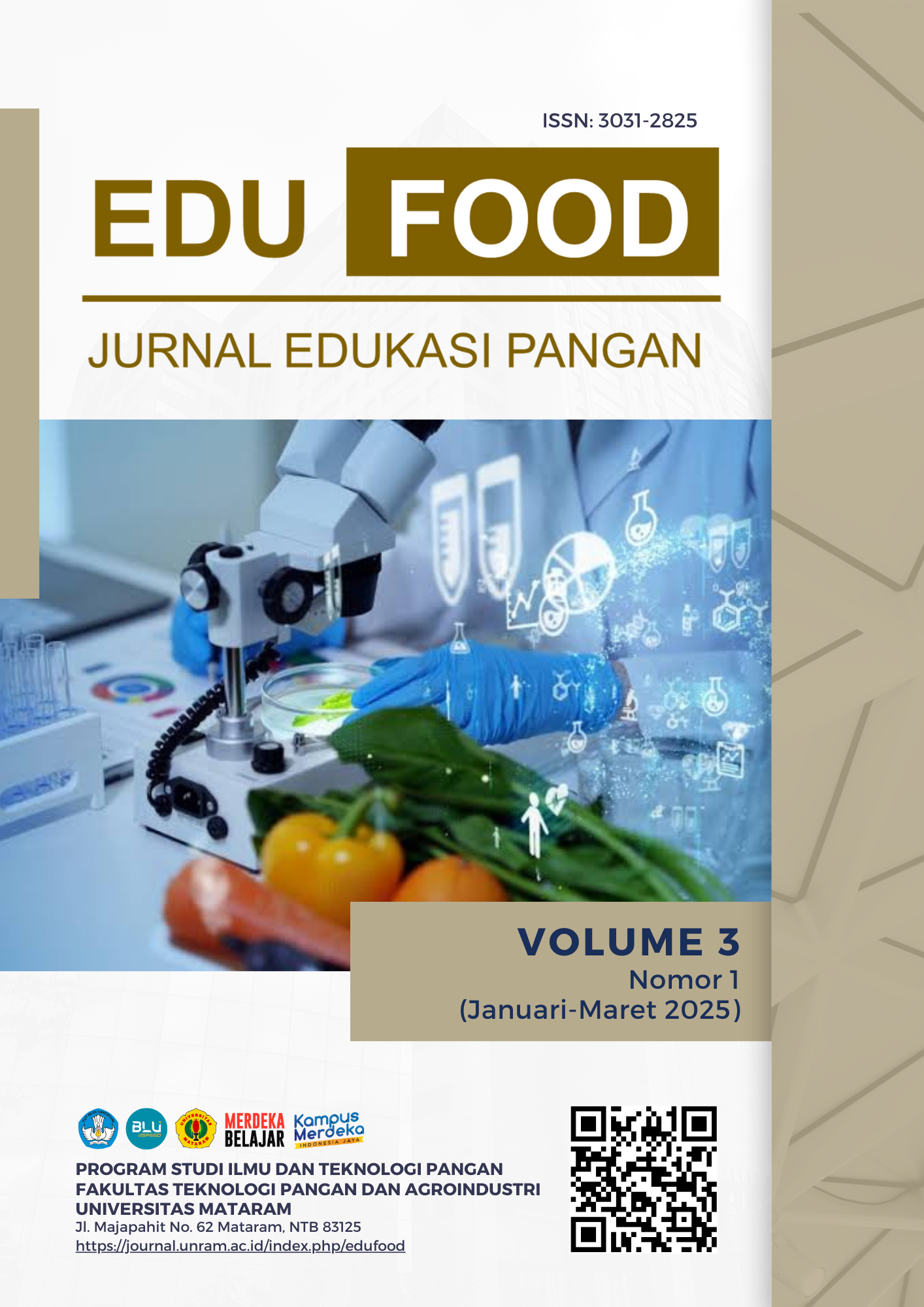THE EFFECT OF WHEAT, SORGHUM, AND CORNSTARCH PROPORTION FLOUR COMPOSITION AND CARRAGEENAN CONCENTRATION ON THE CHEMICAL, PHYSICAL, AND ORGANOLEPTIC QUALITY OF LOW-GLUTEN WHITE BREAD
Keywords:
Bread, carrageenan, composite flourAbstract
This study aims to determine the effect of composite flour proportion (wheat, sorghum, and cornstarch) and the appropriate concentration of carrageenan appropriate for the chemical, physical and organoleptic quality of low-gluten white bread. The method used in this research is an experimental method conducted in a laboratory and designed using a Completely Randomized Design (CRD) with two factors: composite flour proportion (50:25:25, 40:30:30, 30:35:35) and carrageenan concentration (0.2% and 0.4%). The observational data were analyzed using variance analysis at a 5% level with SPSS software. Significant differences were further tested with Turkey's Honest Significant Difference (HSD) test at a 5% level. The parameters observed included chemical quality (moisture content, ash content, and crude fibre content), physical quality (expansion, elasticity, bread pore structure, and staling), and organoleptic quality (aroma, taste, texture, crust colour, and crumb colour). The results showed that the flour composition of 30:35:35 and carrageenan concentration of 0.2% were the best treatments, producing bread with a moisture content of 25.21% (by the SNI standard), ash content of 2.12%, crude fibre content of 7.14%, expansion of 45.16%, elasticity of 64.95%, producing small and relatively non-uniform pores, with the longest staling time of 2 days. The organoleptic properties were described as having a "slightly sour aroma," "non-sour taste," "slightly hard texture," "dark brown crust colour," and "light brown crumb colour," and the bread was preferred by the panellists.References
Arief, D. Z., W. Cahyadi., A. S. Firdhausa. 2018. Kajian Perbandingan Tepung Terigu (Triticum aestivum) Dengan Tepung Jewawut (Setaria Italica) Terhadap Karakteristik Roti Manis. Pasundan Food Technology Journal. Vol 5 (3) : 180-189.
Ariyana, M. D., S. Widyastuti, Nazaruddin., B. R. Handayani dan W. Werdiningsih. 2017. Pengaruh Penambahan Hidrokoloid Iota Karaginan Untuk Meningkatkan Kualita, Keamanan dan Daya Simpan Roti. Jurnal Ilmu dan Teknologi Pangan. Vol 3(1) : 186-193.
Azrai M, dkk. 2021. Teknologi Budidaya Tanaman Sorgum Unggul Bebas Limbah. CV. Cakrawala Yogyakarta. Yogyakarta.
Budijanto, S., Yuliyanti. 2017. Studi Persiapan Tepung Sorgum (Sorghum bicolor L. Moench) dan Aplikasinya Pada Pembuatan Tepung. Jurnal Teknologi Pertanian. Vol 13(3) : 177-186.
Dean, J. 2007. Soft Bread. PT. Gramedia Pustaka Utama. Jakarta.
Desiana, E., T. Y. Hendrawati. 2015. Pembuatan Karagenan dari Eucheuma Cottoni dengan Ekstraksi KOH Menggunakan Variabel Waktu Ekstraksi. Jurnal Semnastek.
Figoni, P. (2010). How Baking Works: Exploring the Fundamentals of Baking Science. John Wiley & Sons.
Istianah, N., Ernawati, L., Anal, AK dan Gunawan, S. 2018. Aplication of Modified Sorgum Flour For Improving Bread Properties and Nutrional Vahues. Journal Internasional Food Research. Vol 25 (1) : 166-173.
Lembong, E., T. Subroto., D. M. Sumanti. 2017. Pembuatan Roti dari Campuran Tepung Sorgum dan Terigu dengan Penambahan α-amilase dan Glukoamilase. Jurnal Penelitian Pangan. Vol 2(1) : 19-24.
Lent, P. J., L. A. Giant. 2001. Effect of Addictives and Stronge Temperature On Staling Properties of bagels. Cereal Chem 78 : 619.
Lestari, D., Kresnowati, M. T. A. P., Rahmani, A., Aliwarga, L., & Bindar, Y. 2019. Effect of Hydrocolloid on Characteristics of Gluten Free Bread from Rice Flour and Fermented Cassava Flour (Fercaf). Reaktor. 19(3): 89-95.
Maulida, Z., Aini, N., Sustriawan, B., & Sumarmono, J. (2019). Formulasi Roti Bebas Gluten Berbasis Tepung Sorgum Dengan Penambhaan Pati Garut Dan Gum Arab. Jurnal Penelitian Pascapanen Pertanian. 16(2) : 90-98.
Murdinah. 2008. Pengaruh Bahan Pengekstrak dan Penjendal Terhadap Mutu Karaginan dari Rumput Laut (Euchema cottoni). prosiding Seminar Nasional Tahun V Hasil Penelitian Perikanan dan Kelautan tahun 2008 Jilid 3. Kerjasama Jurusan Perikanan dan Kelautan UGM dengan Balai Basar Riset Pengolahan Produk dan Bioteknologi Kelautan dan Perikanan.
Mustika, A, S., L. Kurniawati., A, Mustofa. 2015. Karakteristik Roti Tawar Dengan Substitusi Tepung Sorgum (Sorghum bicolor L.) Terfermentasi dan Tanpa Fermentasi. Jurnal Teknologi Hasil Pertanian. Vol 8 (1) : 1-5.
Nawika, N., P. Astuti., H. L. Santosa. Inovasi Pembuatan Roti Tawar Dengan Penambahan Rumput Laut (Euchema sp) untuk Meningkatkan Kandungan Serat. Jurnal Kompetensi Teknik. vol 9 (1) : 60-67.
Pangaribuan, S., T. Nuryawati., A. Suprapto. 2016. Sifat Fisik dan Mekanik Serta Pengaruh Penyosohan Terhadap Sifat Fisik dan Mekanik Biji Sorgum Varietas KD 4. Prosiding Seminar Nasional Pengembangan Teknologi Pertanian. 81-86.
Puspitasari, B. C., Widyastuti, S., & Amaro, M. 2023. Pengaruh Konsentrasi Ragi Roti Instan dan Karagenan Terhadap Mutu Roti Tawar Tersubstitusi Tepung Sorgum. Pro Food (Jurnal Ilmu dan Teknologi Pangan). 9(1): 33-45.
Rauf, R., K. T, Andini. 2019. Sifat Fisik dan Penerimaan Roti Tawar dari Tepung Komposit Terigu dan Singkong dengan Variasi Lama Pencampuran Adonan. Jurnal Agritech. Vol 39 (2) : 169-178.
Suarni. 2004. Pemanfaatan Tepung Sorgum Untuk Produk Olahan. Jurnal Litbang Pertanian. Vol 23(4) : 145-151.
Sudarmadji, Slamet dan B. Suhardi. 2010. Analisa Bahan Makanan dan Pertanian. Liberty. Yogyakarta.
Sutomo, B. 2008. Sukses Wirausaha Kue Kering. Kriya Pustaka, Grup Puspa Swara Anggota IKAPI: Depok.
Syamsir, E., Ruan, R. R. Maretha, H. 2011. Bread Staling. Jurnal Ilmu dan Teknologi Pangan. Vol 8 (1) : 36-47.
Waziroh, E., Murtini, E. S., & Yuwono, S. S. 2023. Aplikasi Teknologi Inovatis pada Pengolahan Roti Bebas Gluten. UB press. Malang.
Zainuddin, A. 2016. Analisis Gelatinisasi Tepung Maizena Pada Pembuatan Pasta Fettuccine. Jurnal Agropolitan. 3(3) : 1-8.


